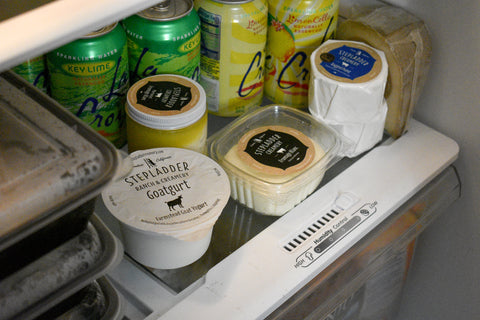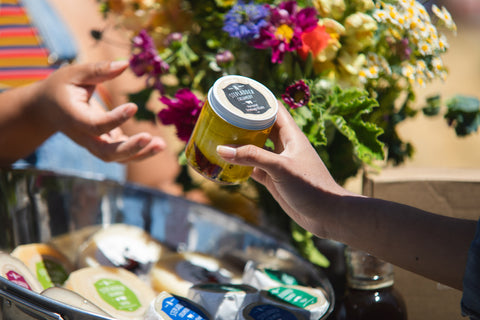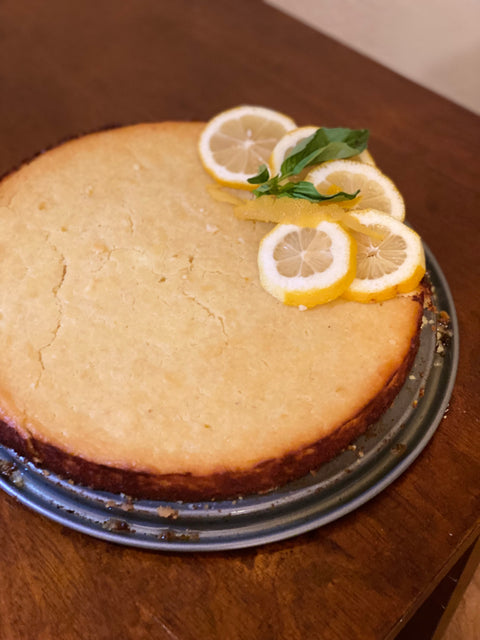When was the last time you cleaned out your fridge? If you're like us, it's probably been a while.
Hopefully, you never have expired Stepladder cheese in your fridge (since you eat it all right away, wink, wink) but if you do, here are some helpful tips to remember about freshness and good vs. bad molds.

Best By Dates
We include a "best by" sticker on every cheese to help you figure out when it was made and how long it's good for.
Our general rule is as follows:
- Fresh Cheeses (Fromage Blanc, Chèvre, Spicy Fromage Blanc, etc.) - 45 Days (Best By from Packaging)
- Triple Crèmes (Ragged Point, Big Sur, etc.) - 60 Days
- Hard Cheeses (Paso Vino, Cabrillo, Lumber Jack, etc.) and Marinated Cheeses - 90 Days
Good vs. bad molds
An example of good mold is Ragged Point, our bloomy rind triple crème. The term “bloomy rind” refers to the fact that the rind on the outside of the cheese is created by a fungal culture that we add to the milk supply. This culture actually “blooms” on the exterior of the cheese over the 2-3 weeks that the cheese ages in our specially designed bloomy rind aging room. This creates a fluffy white rind that protects the interior creamy paste of the cheese.
Read our other blog post and watch the short video about making Ragged Point.
Sometimes cheese can develop mold if stored improperly, exposed to air or used with a dirty utensil.
Typically, mold will come form on the surface of cheeses and can come in many different textures and colors. Usually, green, grey, and blue molds are not harmful and can be scraped off of the surface with the cheese underneath remaining perfectly palatable. If you start getting into bright color molds, that is where it may be time to toss the whole piece of cheese.
The organisms that we are most concerned about are not visible, however, but we have rigorous food safety protocols in place to assure the safety of all of our products.
Side effects of eating bad mold can include allergic reactions, stomach issues and gastrointestinal distress.

Proper Storage
If you don't eat all your cheese in one sitting here are some suggestions to properly store your leftover cheese to eat at a later time. As a reminder, once a package is opened and air makes its way inside, this can impact the longevity of your cheese, especially with our fresh, soft cheeses that have a higher moisture content.
We suggest storing all types of cheese in your refrigerator or other cold storage.
- Fresh Cheeses: Seal tight in original plastic container.
- Triple Crèmes: Rewrap in its original packaging and seal as tight as possible.
- Hard Cheeses: Wrap in original packaging and seal tight with plastic wrap or seal in a ziplock or other container to eliminate air.
Recycle Options
As you probably know, sustainability is very important to us at Stepladder. We do our best to reduce our carbon footprint and partner with vendors and companies also committed to helping our planet. We get a lot of questions about recycling, so here's the gist of our recommendations:
- The glass jars (and their lids) containing Marinated Fromage Blanc or Avocado Blossom Honey can be easily washed out then recycled. You might also want to keep for future use - one of our staff members always brings homemade granola in the small jar to sprinkle on top of her morning yogurt for breakfast. It's also a great size for storing dressings or condiments for work/school lunches.
- Fresh cheese containers are made of plastic, but are 100% recyclable. They can also be washed and reused similarly to other reusable containers.
- Cheese rinds and scraps can be thrown in the compost bin!



